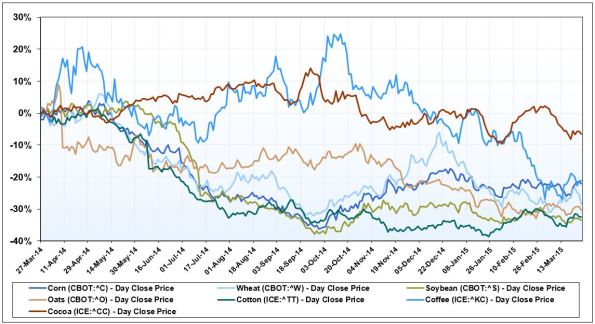Like many, I have been perplexed by what can only be described as the complete cluelessness of the U.S. Federal Reserve. Chairwoman Yellen may speak more plainly than Greenspan or Bernanke, but like her obscure-talking predecessors, her statements are circular and contradictory. In her most recent statement last week, in virtually the same breath Ms. Yellen told us that 1.) “economic conditions have moderated” — which any objective observer can confirm — but also that 2.) “the economy continues growing above-trend.” With 2014 Q4 GDP coming in at another disappointing reading of +2.2%, Ms. Yellen must be referring to imaginary, rather than historical, trends. Neutral outsiders can clearly see that the Fed a.) is biased toward interpreting macro data in a way that conforms to their oversimplified academic theories, and even worse b.) reflexively parrots propaganda to markets that serves the interests of the financial services sector. The main problem, of course, is that the Fed stubbornly insists on implementing policies that increasingly diverge from basic common sense. Their recent “threats” to raise interest rates are, I believe, nothing more than a subterfuge being perpetrated on financial markets. They are merely flicking a few jabs to see how markets would react to actual action on interest rates later this year.
I offer two charts to illustrate why I believe the Fed is merely jawboning about imminent hikes in interest rates. The first chart shows the cumulative percentage change in the price of key agricultural commodities over the past year: Corn, wheat, soybeans, oats, cotton, coffee and cocoa. The average 1-year price decline is -25%. Every single commodity in the chart has declined in price. This is known as deflation, pure and simple, which results from economic weakness. When we look at direct measures of changes in price in this manner, instead of the hedonically- and seasonally-manipulated CPI, PPI, PCE, etc., one simple, common-sense truth is clear — the U.S. is being affected by the global deflationary episode that has persisted for at least the past year. The U.S. economy may be stronger than Japan’s or the Eurozone, but it is still so weak that the prices of key agricultural commodities can decline for an extended period of time. And such price behavior is in no way consistent with “an economy growing above trend.”

The second chart shows the cumulative 1-year percentage price change in gold, crude oil, coal, heating oil, natural gas and copper. Every single physical commodity in the chart has declined in price, with an average 1-year price decline of -27%. Once again, we call this phenomenon deflation — a sign of profound economic weakness.

The Fed is jawboning the market the may Floyd Mayweather uses his jab. They are feeling out markets, which they have never seemed to fully understand in the first place. The Fed is observing the effect of merely talking about higher rates, in case they continue losing their collective mind and would be so stupid as to actually raise rates any time in 2015. The relatively minor volatility we’ve seen in reaction to their jawboning would be many times worse, probably resulting in a “correction” in equities that would approach the -20% threshold for an official bear market. And I don’t think they have the nerve to pull the trigger.
It increasingly appears that Janet Yellen and crew are playing with their monetary policy levers like teenagers addicted to a video game. In a market suffering from numerous unpriced risks, the Fed’s utter cluelessness may be the biggest unpriced risk of all.


Deflation is the Main Reason the Fed Will Raise Rates Later Rather Than Sooner
Like many, I have been perplexed by what can only be described as the complete cluelessness of the U.S. Federal Reserve. Chairwoman Yellen may speak more plainly than Greenspan or Bernanke, but like her obscure-talking predecessors, her statements are circular and contradictory. In her most recent statement last week, in virtually the same breath Ms. Yellen told us that 1.) “economic conditions have moderated” — which any objective observer can confirm — but also that 2.) “the economy continues growing above-trend.” With 2014 Q4 GDP coming in at another disappointing reading of +2.2%, Ms. Yellen must be referring to imaginary, rather than historical, trends. Neutral outsiders can clearly see that the Fed a.) is biased toward interpreting macro data in a way that conforms to their oversimplified academic theories, and even worse b.) reflexively parrots propaganda to markets that serves the interests of the financial services sector. The main problem, of course, is that the Fed stubbornly insists on implementing policies that increasingly diverge from basic common sense. Their recent “threats” to raise interest rates are, I believe, nothing more than a subterfuge being perpetrated on financial markets. They are merely flicking a few jabs to see how markets would react to actual action on interest rates later this year.
I offer two charts to illustrate why I believe the Fed is merely jawboning about imminent hikes in interest rates. The first chart shows the cumulative percentage change in the price of key agricultural commodities over the past year: Corn, wheat, soybeans, oats, cotton, coffee and cocoa. The average 1-year price decline is -25%. Every single commodity in the chart has declined in price. This is known as deflation, pure and simple, which results from economic weakness. When we look at direct measures of changes in price in this manner, instead of the hedonically- and seasonally-manipulated CPI, PPI, PCE, etc., one simple, common-sense truth is clear — the U.S. is being affected by the global deflationary episode that has persisted for at least the past year. The U.S. economy may be stronger than Japan’s or the Eurozone, but it is still so weak that the prices of key agricultural commodities can decline for an extended period of time. And such price behavior is in no way consistent with “an economy growing above trend.”
The second chart shows the cumulative 1-year percentage price change in gold, crude oil, coal, heating oil, natural gas and copper. Every single physical commodity in the chart has declined in price, with an average 1-year price decline of -27%. Once again, we call this phenomenon deflation — a sign of profound economic weakness.
The Fed is jawboning the market the may Floyd Mayweather uses his jab. They are feeling out markets, which they have never seemed to fully understand in the first place. The Fed is observing the effect of merely talking about higher rates, in case they continue losing their collective mind and would be so stupid as to actually raise rates any time in 2015. The relatively minor volatility we’ve seen in reaction to their jawboning would be many times worse, probably resulting in a “correction” in equities that would approach the -20% threshold for an official bear market. And I don’t think they have the nerve to pull the trigger.
It increasingly appears that Janet Yellen and crew are playing with their monetary policy levers like teenagers addicted to a video game. In a market suffering from numerous unpriced risks, the Fed’s utter cluelessness may be the biggest unpriced risk of all.
Share this:
Related